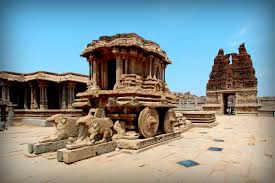GS I-History

About Hampi
- Located in Karnataka’s Bellary District, Hampi lies along the banks of the Tungabhadra River.
- It served as the capital of the Vijayanagara Empire, one of South India’s most prominent Hindu empires, thriving between the 14th and 16th centuries. Recognized as a UNESCO World Heritage Site in 1986, Hampi is an archaeological treasure.
- Vijayanagara architecture exhibits influences from various South Indian styles, such as Chola, Hoysala, Pandya, and Chalukya, along with elements of Indo-Islamic design.
- The architecture of Hampi is renowned for its intricate Yali (horse) carvings and Kalyan Mandapas (marriage pavilions).
- The ruins include the Mahanavami Dibba (a ceremonial platform), numerous stepped tanks, and a network of pillared halls (Mandapas).
- Hampi’s temples are celebrated for their monumental size, intricate sculptures, bold reliefs, and majestic pillars, with many depicting scenes from the epics Ramayana and Mahabharata.
Noteworthy Temples in Hampi
- Virupaksha Temple: A revered Shiva shrine.
- Vittala Temple Complex: Famous for the Stone Chariot and musical pillars.
- Hazara Rama Temple: Known for its exquisite bas-reliefs narrating the Ramayana.
- Lakshmi Narasimha Temple: Houses a massive monolithic statue of Narasimha.
- Achyutaraya Temple: Notable for its detailed sculptural work.
Hampi was distinguished by its broad chariot streets, lined with pillared pavilions and bustling bazaars. Given the region’s dry climate, the Vijayanagara rulers devised sophisticated water management systems, including the Kamalapuram tank and Hiriya canal, to support agriculture and urban water needs.
Colonel Colin Mackenzie, an engineer and antiquarian, was one of the first to document Hampi’s ruins in the early 19th century.
The Vijayanagara Empire
- Founded in 1336 CE by Harihara and Bukka Raya, Hampi was chosen as the capital.
- The empire was ruled by four key dynasties: Sangama, Saluva, Tuluva, and Aravidu.
- At its zenith, Vijayanagara extended across South India, encompassing parts of the Deccan and Odisha.
- It played a significant role in resisting the Deccan Sultanates and controlling the trade routes beyond the Tungabhadra-Krishna River.
- The empire’s economy thrived on agriculture and a flourishing trade network. Key exports included spices, textiles, and gemstones, while coins were minted in gold, silver, copper, and brass.
- The decline of Vijayanagara began following the catastrophic Battle of Talikota in 1565, which led to the empire’s eventual downfall.
Conservation Initiatives
- UNESCO Heritage Status: Since its inclusion as a UNESCO site in 1986, efforts to preserve Hampi have intensified.
- Restoration Projects: Various initiatives focus on reconstructing and maintaining the site’s ruins and temples.
- Funding & Collaborations: The conservation of Hampi is backed by governmental support, international organizations, and heritage experts.
- Public Awareness Campaigns: Efforts to educate visitors and locals promote responsible tourism and heritage conservation.
- Infrastructure Enhancements: Development projects aim to manage tourism efficiently while preserving the historical landscape.
Challenges Faced by the Local Community
- Economic Dependence: The heavy reliance on tourism makes the local economy vulnerable to fluctuations in visitor numbers.
- Cultural Strain: A surge in tourism can disrupt local traditions and alter the cultural fabric of the region.
- Infrastructure Pressure: Increased footfall places strain on transportation, sanitation, and public facilities.
- Environmental Damage: Rising visitor numbers and urban development can impact both historical sites and the surrounding environment.
- Shifting Livelihoods: Traditional occupations, like agriculture, are increasingly overshadowed by tourism-related businesses.
- Community Displacement: Conservation and development projects may lead to relocation or lifestyle changes for local residents.
The Road Ahead
✔ Sustainable Tourism: Implement regulations such as visitor limits and eco-friendly initiatives to ease the burden on resources and heritage sites.
✔ Community Participation: Involve local communities in decision-making and conservation efforts to balance heritage preservation with sustainable development.
✔ Infrastructure Development: Enhance sanitation, transport, and waste management systems to accommodate tourists without compromising Hampi’s historical essence.
✔ Economic Diversification: Encourage alternative sources of income, such as handicrafts, agriculture, and cultural experiences, to reduce over-reliance on tourism.
✔ Education & Awareness: Promote heritage conservation among visitors and locals to foster respect for Hampi’s historical and cultural significance.




